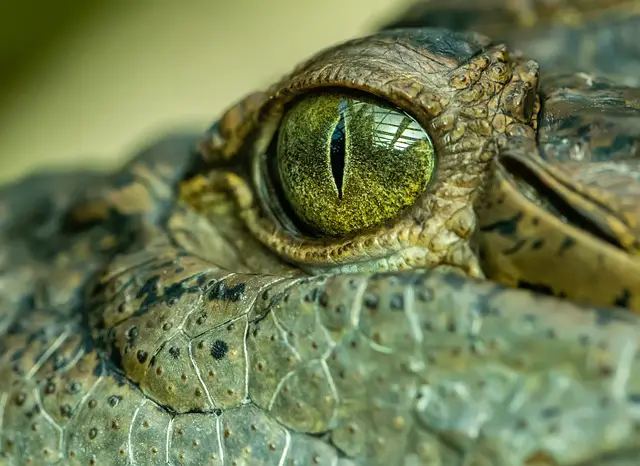Make a move and enjoy some of the most amazing crocodile facts for kids. A crocodile is a reptile that belongs to the family of Crocodylidae and the subfamily of Crocodylinae. These animals are best known for their fearsome reputation and are placed as the most aggressive reptiles across Africa. Crocodiles are the inhabitants of Asia, Africa, America, and Australia. These reptiles make their habitats in freshwater streams, lakes, wetlands, rivers, and brackish water. They predominantly feed on mollusks, fish, reptiles, crustaceans, medium-sized mammals, and rarely on invertebrates. Crocodiles are believed to have been evolved some 55 million years ago in the period of Epoch.
Interesting Crocodile Facts For Kids
- Crocodiles are placed as one of the most complex reptiles biologically.
- These reptiles are mostly found in water such as lakes, wetlands, and rivers as compared to the land.
- The physical traits of crocodile enable it to be a popular predator.
- Crocodiles are very swift animals in short bursts in and out of water.
- They tend to grab their prey and start rolling it over the water surface to drown it. The crocodile’s bite force is about 5,000 pounds per square inch (30,000 kPa). The bite force of Rottweiler is just 335 pounds per square inch (2,300 kPa); the great white shark has 400 pounds per square inch (2,800 kPa).
- There are several crocodiles that are known to ingest stones which may serve as important ballast to balance their bodies.
- Crocodiles can generate different sounds in times of aggression and distress. These animals are capable to hear well.
Dig Deeper: What Do Crocodiles Eat
 They primarily feed on birds, mammals and rarely on small crocodiles.
They primarily feed on birds, mammals and rarely on small crocodiles.- These animals are given protection worldwide but on the negative side crocodiles are also farmed commercially. Their skins are employed for making leather, shoes, and handbags. Saltwater crocodiles and nile crocodiles are the most common crocodilian species that are farmed commercially.
- These reptiles are most closely related to dinosaurs and birds.
- These animals are also capable to make short bursts on land on their belly. The crocodile’s speed is about 17 km/h (11 mph).
- Crocodiles lack sweat glands and they discharge heat by way of their mouths.
- These animals often sleep with open mouths.
- Depending entirely on species, crocodile’s length varies significantly. Some of the species such as Palaeosuchus and Osteolaemus measures around 1 meter (3.3 feet) to 1.5 meters (4.9 feet) in length. The larger crocs can be as long as 4.85 meters (15.9 feet), with the weight measuring at 1,200 kg (2,600 lb).
- The two of the largest crocodiles measure around 6.2 meters (20 feet). These two were hunted down in 1974 and poachers were largely responsible for their deaths.
- The largest captive crocodile ever recorded measured at 6 meters (19.69 feet) in length and weighs around 1114.27 kg. Another crocodile species that was kept in captivity and is alive measured around 6.17 meters (20.24 feet), with the weight measuring at 1,075 kg.
- According to the wildlife experts, the longest crocodile ever recorded is 23 feet (7.0 meters) in length. This is found in Bhitarkanika.
- The average lifespan of these animals is about 60 – 100 years, with the oldest croc ever lived died in Russia at the age of 130 years.
Dig Deeper: Types of Crocodiles in the World
Feeding Ecology & Diet
Crocodiles are sabotage hunters and they consume diverse animals. They are opportunistic hunters and will eat whatever they find their way. The crocodile’s diet is mainly composed of birds, frogs, snakes, turtles, insects, and snails. It seldom attacks humans unless provoked. The crocodile’s snout precisely gives you a view as to which kind of diet it relies on.
The African slender-snouted crocs and false gharials are known to consume plenty of fish. Since they have narrow snout, they can easily go against water to grab a fish. However, the thinner snout is vulnerable as compared to the wider one, which is why they rely on fish and not on animals that could fight hard and possibly harm the snout.
Some of the bigger crocs such as Nile and Indopacific crocodiles have relatively broader snout which allows them to eat large land animals including buffalo and wildebeests. Except in certain circumstances when they are too hungry, crocodiles are nocturnal hunters.
Crocodiles are not known to chase the land animal even though they can charge out of water. They seldom go after the prey for a simple reason that cold-blooded animals cannot store and make large amounts of energy. They wait for the prey to come as near as possible. Crocodiles swallow the whole prey as they can’t chew. It gulps down the prey by placing the head upwards and opens its jaws. The prey goes into the back of the mouth and is finally swallowed.
Amazing Crocodile Facts For Kids
Do you know if you cut crocodile’s limbs and hands, it can still swim with its powerful tail for about 25 miles per hour?
The captive crocodiles can grow to a length of 5 feet in a year.
Some people think if crocodiles open their mouths on river banks, it is likely to attack you; although it may seem so but it’s not true. They open mouths in order to release some heat because these reptiles sweat through their mouths. It is not a sign of aggression.
Never approach crocodiles in the monsoon season because they become more aggressive than they ever are due to mating season.
The crocodile’s teeth are not used to munch on food, in fact it crushes its prey with these sharp teeth and swallow the whole. They also take some stones along with food as these stones serve as a ballast to grind hard food.
Only 10% of the crocodile’s broods reach adulthood as they are often eaten by monitor lizards, herons, and other male crocodiles.





